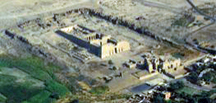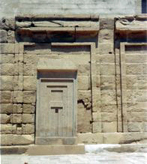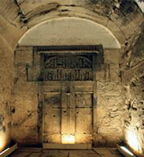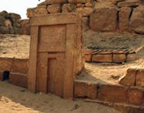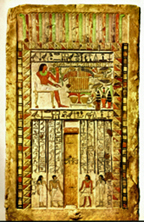“假门”——物理形而上学的门槛
在古埃及历史各个时期的所有埃及寺庙、神殿和私人坟墓的西侧,墙上总是有一条裂缝,或者通常被描述为 假门.
西方是逝去的灵魂的进入点。它是物质尘世领域和形而上学领域之间的门槛。
“假门”基本上是一种带有石插座的凹墙,其细节类似于能够打开和关闭的普通门/窗。 “假门”可以采取以下形式:梅赫拉布',墙上的一个壁龛,可能包含雕像或遗物。
在神圣的神庙中,假门位于圣所的最后面,充当神圣领域和人类领域之间的界面。
传入的人类行为形式和定向流动在假门处结束,神圣祝福的流出开始并向外流向寺庙的入口。
例如,看看卢克索西岸梅迪内哈布 (Medinet Habu) 的巨大寺庙,以及它的西墙 —
我们发现——假门:
再往北,在阿比多斯,我们在西墙上发现了类似的假门。
同样,在吉萨高原的数百个坟墓/马斯塔巴:
萨卡拉坟墓的西墙也发现了假门:
“假门”这个词本身就有点用词不当,因为从埃及人的角度来看,这些特征是功能齐全的门户,死者的灵魂可以通过这些门户离开或进入内墓,接受献给他们的祭品。
Complementary features at false doors in tombs:
1. Most of these panels show the owner in standing or seated poses before a table of offerings. The figure of the owner is carved in a frontal aspect, stepping out over the threshold of the door. The reliefs of the deceased in a standing pose also appear on the jambs of the false door, thus representing the owner coming forth to receive the funerary offerings.
2. A table of offerings in front of the deceased figure is piled with sliced loaves of bread and simple texts enumerating various food and drink offerings which extend in range from the staple bread and beer to beef and fowl, vegetables, clothing, and sacramental oils. The altar, with its slices of bread, may be supplemented by other tables containing offerings or libation vessels.
3. Visitors are bringing the sacrificial animals and birds and cutting up the sacrificial bull at the door of the tomb. In the middle is the deceased man, seated under his pavilion (signifying a different realm) and receiving the sacrifice.
4. Behind the door is the main burial shaft. The main shaft led from the middle of the roof of the mastaba to the burial chamber.
“假”门的节日聚会
逢年过节、祭祀之日,来客按惯例设宴时,这尊大画人物,在火把摇曳、烟灯闪烁的灯光下,行进中,很可能显得生机盎然。就好像已故的祖先亲自从墙中走出来,神秘地站在他的子孙面前,向他们的子孙致敬。门楣上的铭文再次重复了死者的姓名和等级。门柱上的浅浮雕上有他和他的其他家庭成员的忠实肖像。场景中,他静静地坐在桌旁,身边详细记录着宴会的细节,从端水给他洗澡的那一刻,到他厨艺用尽,只得返回住处。处于一种幸福的满足状态。
在神圣的眷顾下,灵魂(或者更确切地说,面包、肉和饮料的分身[Ka-s])进入了另一个世界,并在那里刷新了人类的分身[Ka]。然而,发行并不一定要有物质存在才能有效。第一个来的人应该大声重复刻在石头上的名字和公式,仅通过这种方式,就可以确保未知的占有者立即拥有他所列举的所有东西。
[摘录自 穆斯塔法·加达拉 (Moustafa Gadalla) 的古埃及形而上学建筑]
